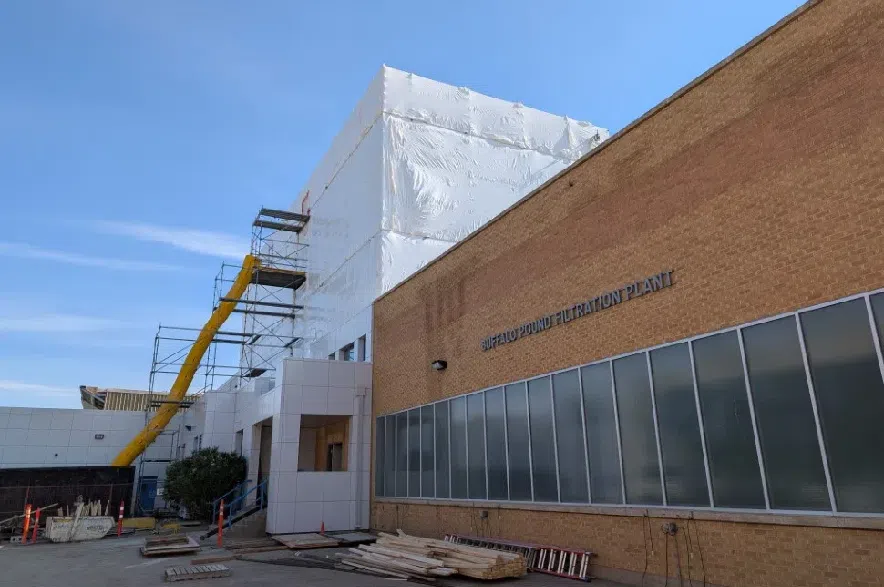The situation at the Buffalo Pound Water Treatment Plant (BPWTP) has been ‘fluid’ since about 2017, explained Ryan Johnson, president and CEO of the BPWTP Corporation — but the finish line is in sight, giving the plant’s operators hope of settling into a routine in the near future.
“All the operators, all the staff here, we’re here to produce water,” Johnson said during a June 4 media tour of the still-under-construction facility. “That’s because when we go home at night, we want to make sure that the water everyone drinks, including our own families, is safe.
“So, the operators are absolutely dedicated to ensuring water quality, to the point where if they see something they don’t like, they will make sure to tell. They’re very vocal.”
Read More:
- Premiers huddle with Carney in Saskatoon to decide what major projects to prioritize
- More evacuations triggered by Sask. wildfires as evacuee space runs short
- ‘We’re going to stand with the victims’: Saskatoon Intimate Partner Violence team removing barriers
And they’ve had to be, Johnson noted wryly, because the list of things that have gone wrong since they began re-designing the plant in 2016 is a long one. From unreliable contractors to hiccups in switching over from old systems to new, from struggling with sludge management to now having to incorporate new fluoride systems for Regina, operators have worked sometimes around the clock to ensure the water flows.
“This isn’t just engineering; this is public health. And really, a safe, reliable water supply is the core of public health,” Johnson said. “We can’t just do things a different way or adapt the way civil engineers do when they’re building a road and something gets in the way — the water has to meet a minimum, consistent standard at all times. That’s our mandate.”
The BPTWP was built in the ‘50s, when technology was vastly different. By 2022, when the $325 million Renewal Project began, the plant was on its last legs, with an antiquated filter system nearing uselessness. The systems also left operators at the mercy of things like algal blooms or big temperature swings in Buffalo Pound Lake, resulting in regular outbreaks of bad taste and odour, even though the water was still safely drinkable.
The renewal project will ensure the plant has everything it needs to continue delivering water to over 270,000 people in Regina and Moose Jaw, and will create a more consistent, pleasant taste. New technologies include the Dissolved Air Flotation System (DAF), which is a fundamental shake-up.
“I find it amazing that we ran this plant, forever, for everything to settle and sink,” Johnson explained. “We always fought against things rising and floating. Dissolved Air Flotation is … actually easier to treat.”
The DAF system is one of the first things water has to go through after being pumped 82 meters up and three kilometres over to the plant from Buffalo Pound Lake. Pressurized nozzles fill the intake with billions of bubbles, which attach to the clay, silt, algae, viruses, and everything else, lifting it to the surface as ‘sludge’, and leaving clear water underneath. The sludge is mechanically scooped off the top and pumped outside to settling ponds. At the ponds, the water separates and is drained back to the lake, while the dehydrated sludge is removed by heavy equipment.
Another change is in the filtration that happens after the DAF. Previous systems used inorganic filtering — a mixed-media layering of coarse anthracite and sand that became saturated with impurities relatively quickly and needed regular replacement.
Now, they use biological activated carbon (BAC) filters, recruiting nature to work on their side instead of fighting it. The filtration medium uses carbon granules to trap impurities, and over time ‘good’ bacterial colonies form which consume any remaining organic material — before ‘bad’ bacterial species can eat it and start growing out of control. The carbon is flushed daily, renewing the cycle. Not only is this system better at filtering, it lasts long years before needing replacement.
There’s more: A new ozone treatment system will make taste concerns a thing of the past. The system blasts the water with the powerful oxidative gas, reacting with many contaminants and destroying them before they can, again, be food for bad bacteria — or ruin the taste of our tap water.
There’s also UV light treatment, which uses the same kind of radiation that comes from the sun to damage the DNA of certain bacteria. Cryptosporidium and Giardia sneak through filters and are unaffected by chlorine, but UV light treatment renders them harmless.
Fluoride is added for its well-known dental health benefits, and the last chemical additive is chlorine. Chlorine is added in trace amounts to prevent bacterial regrowth in the pipes leading to reservoirs in Moose Jaw and Regina. By the time the water arrives, the chlorine is almost undetectable — but Johnson said it is an essential part of a safe drinking supply.
“Chlorine has to be up there with penicillin in terms of saving lives,” he noted. “Water-borne illnesses used to be how most people died in disease outbreaks. That doesn’t happen anymore, and that’s because our processes work.”
Construction on the operating systems should be completed by this September, with the caveat that it was also supposed to be complete by last September. Overall work should be finished by next June. After that, operators can get used to the new plant and hopefully shed some of the anxiety of the last few years’ disruptions.
“I think it’ll be nice, when the project is done, to take a deep breath, then look at efficiency improvements,” Johnson said. “But, you know, technology and research keep advancing, so we’ll always find new ways to do things.
“We spend money on research all the time, to understand how to be efficient, but also to learn from what’s going on in the water and how it impacts people.”











